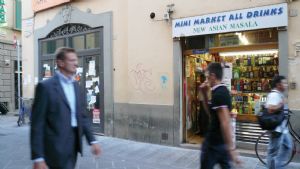What do holes and Medieval Crusaders have in common? Buttons! When the Crusaders returned to Europe from the Middle East during the 1100s and 1200s they brought the buttonhole back with them. Although buttons had been used to decorate clothing since ancient times, with the arrival of the buttonhole, they were also given a function. A button pulled through a buttonhole fastened one part of a garment to another. And when they were on sleeves, as they most often were, you could finally button up on your own!
The button has played this dual role of decoration and function for nearly a thousand years, and because the button is linked to clothes, that is fashion, it reflects or complements the style of the particular period in which it was created (keep in mind that styles used to endure much, much longer than they do in our day and age). The button, therefore, can also be studied as a mirror of the history of arts and crafts on a miniature scale.
Nowhere is this made clearer than in the exquisite, and appropriately small, exhibition currently at the Galleria del Costume, Palazzo Pitti. In Appesi a un filo, the curators display a part of the button collection formed by the north Italian engineer Alberto Riva (1848–1924) and acquired by the Galleria del Costume in 2006.
Riva’s buttons range from the seventeenth to the twentieth centuries, the majority dating from the eighteenth century. They are shown as Riva himself had arranged them, grouped according to typology and attached to cloth-covered panels. The curators have occasionally added other objects to the display, such as porcelain or prints, to accentuate the interrelationship of the arts and crafts during earlier historic periods.
Many of the buttons are truly beautiful; nearly all of them are fascinating because of the shapes, colours and textures. Their workmanship will astound you. Every student of design should be required to visit the exhibition, for inspiration if nothing else.
Before buttons were mass-produced in the nineteenth century, they were made by goldsmiths, silversmiths and artists, who used costly materials like ivory, glass, crystal, amber, pearls, porcelain, besides gold and silver. Cheaper buttons were carved from wood and bone.
But beauty and wealth, then as now, had their drawbacks. If your garment was adorned with precious buttons, you risked being robbed, like the man in fourteenth-century Venice, accosted by a thief who snipped the 36 buttons off his tunic sleeves. Or you risked being fined: in fourteenth-century Florence, sumptuary laws stated that buttons had to be accompanied by buttonholes; in other words they had to be functional.
As the Riva exhibition illustrates, from the seventeenth to the early twentieth centuries, the button enjoyed glorious periods of heady extravagance. Even though it has since returned to being primarily functional, its survival is threatened. (Enemy number one of the modern button is that vulgar villain Velcro.) Thirty years ago there was one button shop after another in Florence. Today you have to hunt for them. Buy buttons before they vanish forever! Or at the very least, start collecting them.
Appesi a un filo, until 27 April, Galleria del Costume, Palazzo Pitti.
Hours: daily 8:15 to 16:30 (January-February); 8:15 to 17:30 (March); 8:15 to 18:30 (April) www.firenzemusei.it







